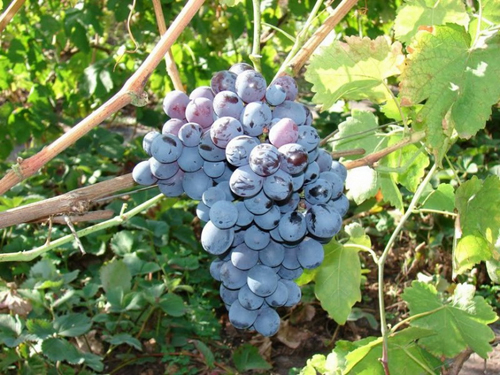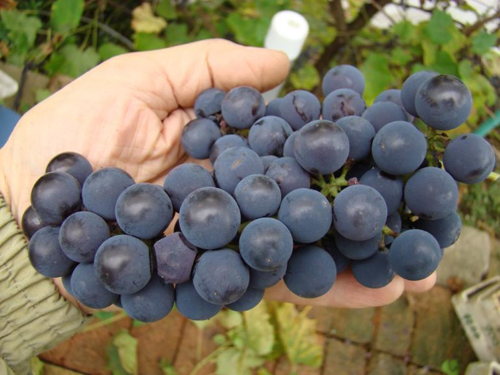Alpha grape variety
In the opinion of many, grapes are an exclusively southern plant, which, if grown in the northern regions, is associated with significant labor costs, associated primarily with the need to carefully cover the vine for the winter. Or are there varieties that can grow in northern climates without unnecessary worries to protect them from frost? It turns out that there are some. One of them is a hybrid form of grapes called Alpha, which is well known to the inhabitants of the non-black earth zone of the European part of Russia, the Far East and even the south of Siberia with its fierce winter cold. Without shelter for the winter, this variety can grow up to Novgorod, which seems fantastic for winegrowers who are used to dealing with southern varieties. The culture is zoned in the Primorsky Territory of the Russian Federation, but it is found everywhere in the northern regions of Russia.

This variety belongs to the group of so-called "isabel", and its fruits are so similar to itself Isabellathat they are often confused with each other. However, although Isabella is also quite resistant to frost, she cannot compete with Alpha in this regard, which is why she is cultivated much further south. Our hero comes from North America, where he was born as a result of one of the many natural crosses of the local Vitis labrusca grape with one of the introduced European varieties of the Vitis vinifera species. Subsequently, the hybrid was noticed by one of the winegrowers, began to be cultivated and multiplied as a cultural form, and then brought to our country for the study of American hybrids, eventually gaining distribution in northern regions that are unconventional for conventional viticulture. The presence of the “labrus” parent predetermined the strong, specific strawberry aroma of berries inherent in all “isabelle” varieties. Alpha conditionally refers to technical grapes, however, it is of little use for the production of wine due to the low sugar content and excessive acidity of the grape must. More suitable for landscaping, since the vine can reach a height of 9 meters, and the plants themselves are very resistant to diseases and pests.
Agrobiological characteristics
The bushes are vigorous. The leaves are dark green, large, rounded, usually have three lobes and a medium degree of dissection. The surface of the leaf blade is rough, underneath it is covered with dense felt-type pubescence. The lower lateral notches of the leaf are absent, the upper ones are shallow, open, and look like a reentrant corner. The petiole is open, vaulted, narrow, with a rounded bottom. Alpha's flowers are bisexual and can be pollinated with their own pollen. The variety is not prone to peas.

Bunches of grapes are medium in size, with an average weight of 100-200 grams. In shape, they can be both cylindrical and cylindrical-conical, on some you can see one small "wing". Medium to high bunch density. They have a strong attachment to the vine with a medium-long comb, while the stems of the berries are usually short. The berries are round, medium in size, have a diameter of 17-19 mm and a weight of 2 to 3 grams. The pulp is greenish with a yellow tinge, slimy consistency. In the taste and aroma, the strawberry tones characteristic of American hybrids are actively manifested. The skin is thick, elastic, dark in color with a purple or reddish-brown tinge, the outside is covered with a dense layer of pruin bloom. The seeds are large, their number is usually 2-3, they are separated from the pulp. Cracking and decay of berries in Alpha, as a rule, is not observed.
The harvest of this variety can be used in home canning for the preparation of fragrant compotes or jam. Suitable for fresh consumption. It is practically not used in winemaking, as the resulting wine is sour and unstable due to its low alcohol content. In addition, a strong "labrus" aroma in wine is considered today among gourmets a sign of bad taste.

The grapes ripen in medium terms. For this, 140-145 days of growing season and a total of 2750-2850 ° C of active temperatures are enough for him. Shoots ripen very well along the entire length, while acquiring a reddish-brown color. The winter hardiness of the bushes is very high. Plants can withstand frosts of -30 -35 ° C without any problems. They can be used to inoculate less frost-resistant varieties on them. Alpha's yield is very high - 150-180 kg / ha. From a large, mature, well-developed bush, up to 100 or more kilograms of grapes can be harvested. This is ensured, among other things, due to the large number of bunches on the vines - on each fruitful shoot there can be 2-3 or even more of them. The number of fruiting shoots is also high, reaching 70-80%. Even shoots that have grown from replacement buds are productive, if for some reason the main ones have died.
The sugar content of the juice of ripe berries is 15-17 grams / 100 cubic meters. cm, while the acidity is 10-11 grams / l.
Agrotechnical features
There is practically no difficulty in growing Alpha. As already mentioned, it has a high resistance to pests and diseases of grapes, easily tolerates low winter temperatures without shelter, and easily reproduces by rooting cuttings. It is also resistant to phylloxera, so there is no need to fear the death of plants planted on their own roots. Moreover, even it itself can act as a rootstock for more whimsical varieties.
Chemical treatments are not required, however, in some cases, the bushes may show signs of chlorosis. The problem is especially common in vineyards located on heavy, poorly drained and aerated soils in regions with a humid and cold climate. The problem is most often associated with the inaccessibility of iron ions for plants, or such trace elements as copper, manganese, zinc, molybdenum and cobalt. It manifests itself most often in the form of the appearance of yellow spots on the leaves between the veins, while the veins themselves remain green. The problem can be solved by watering grapes with a 1-1.5% solution of ferrous sulfate at the rate of 3-5 liters per bush, or Alfa foliar dressing with a mixture of trace elements.
It does not need to ration the load with shoots and crops, the length of the pruning can be either short (3-5 eyes) or medium (6-9 eyes). The only thing that should not be allowed is excessive thickening of the bushes, for which it is necessary to break off excess and weak shoots, "doubles" and "tees" that have grown from one eye, and also regularly carry out pinching. A bush of grapes is usually formed on a high trunk with powerful horizontal cordons and sleeves. Often this variety is used for landscaping, forming it on arches with several levels of arms diverging to the sides. Fruit links are placed on the sleeves, and at the height of the growing season, the bushes form living walls and the vault of an arch or gazebo. Alpha is quite capable of withstanding colossal volumetric formations, because potentially plants can grow very high. They are often used to decorate the facades and balconies of residential buildings.
All this suggests that, despite the low adaptability of the crop formed by the variety, this grape has many other positive characteristics that make it in demand in regions where other varieties simply would not survive. This is not to say that the circle of Alpha fans is too large, but their consistently positive reviews about him indicate that time has not passed at all and he will not free his niche soon.








